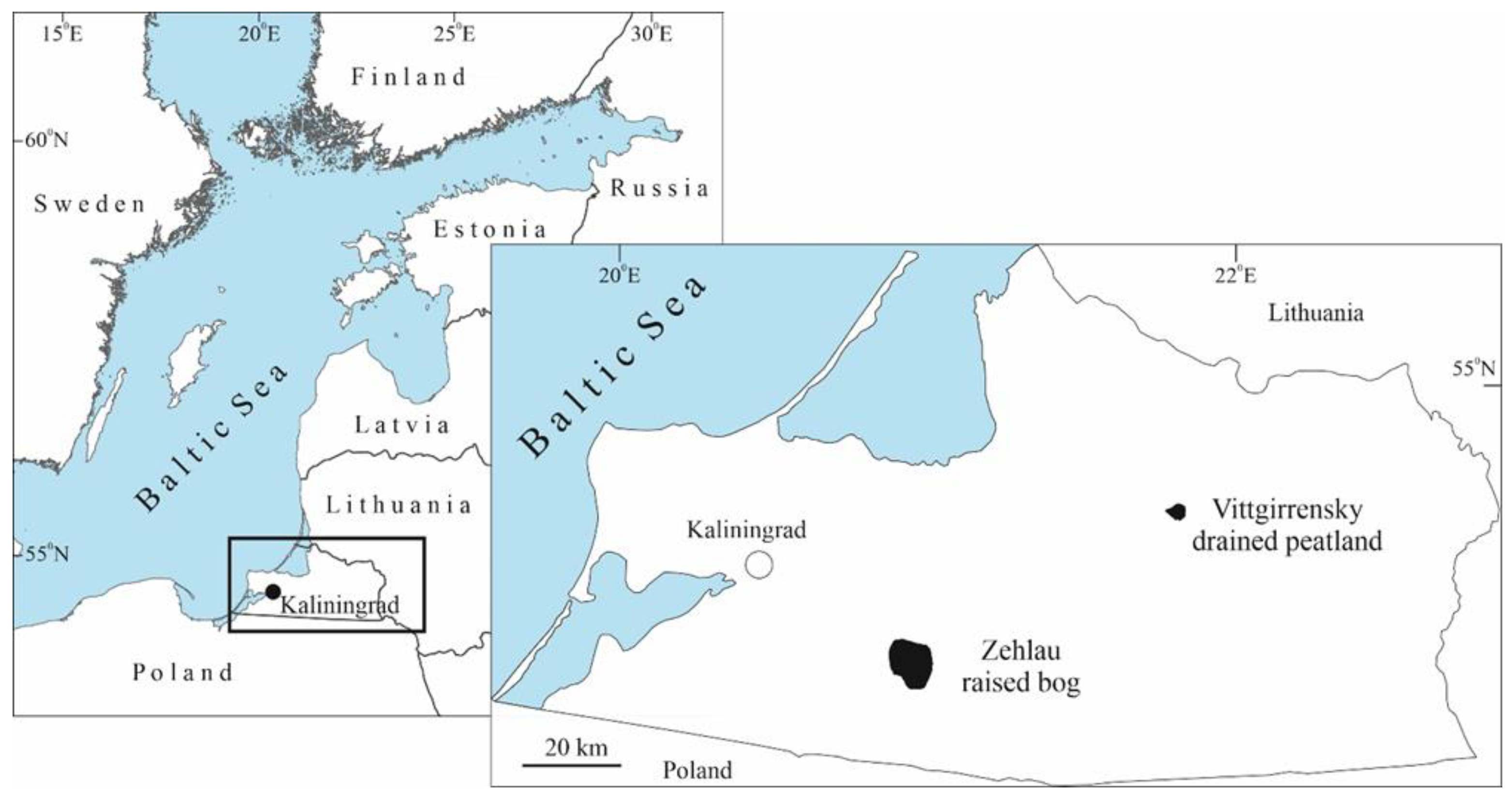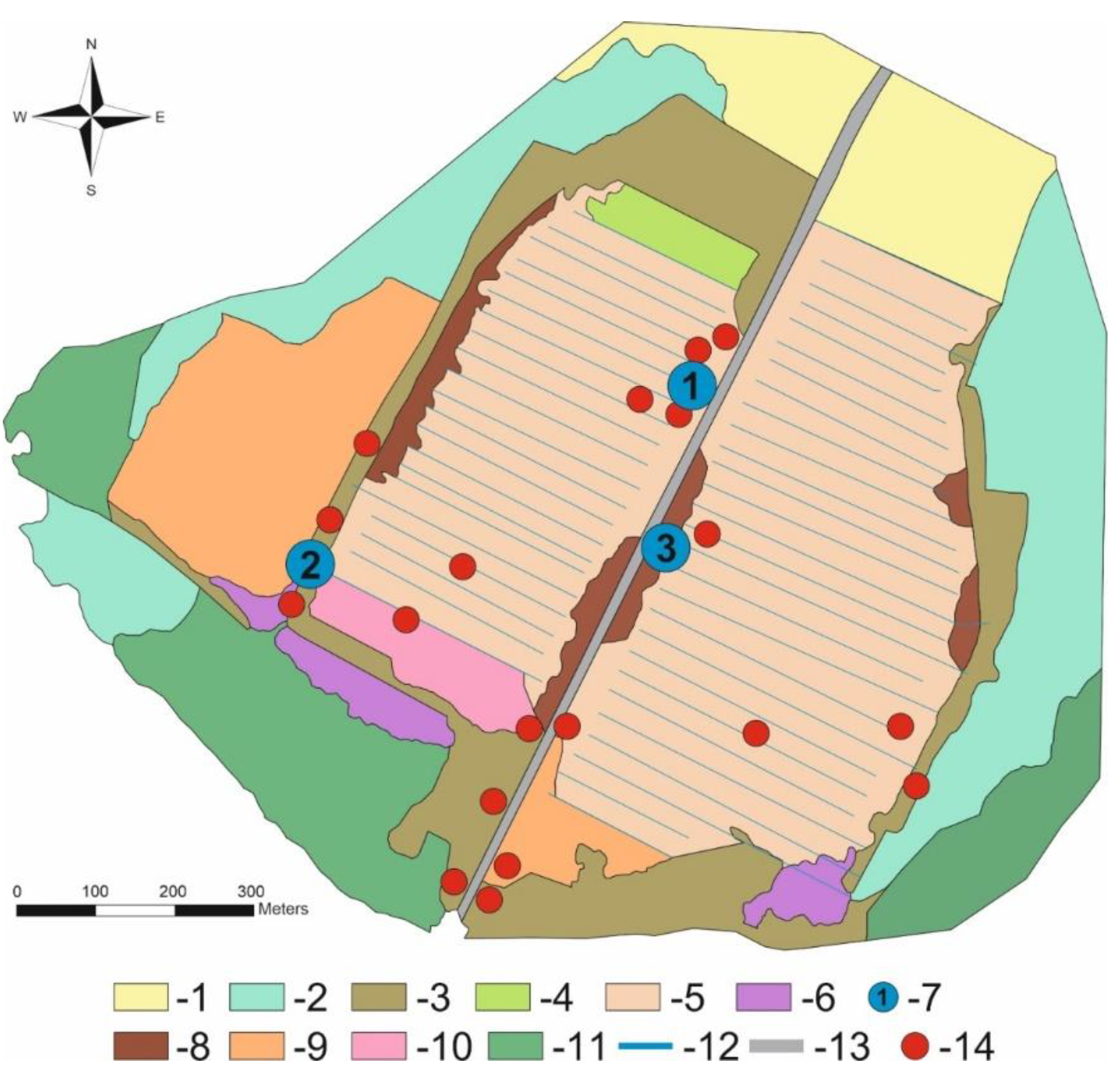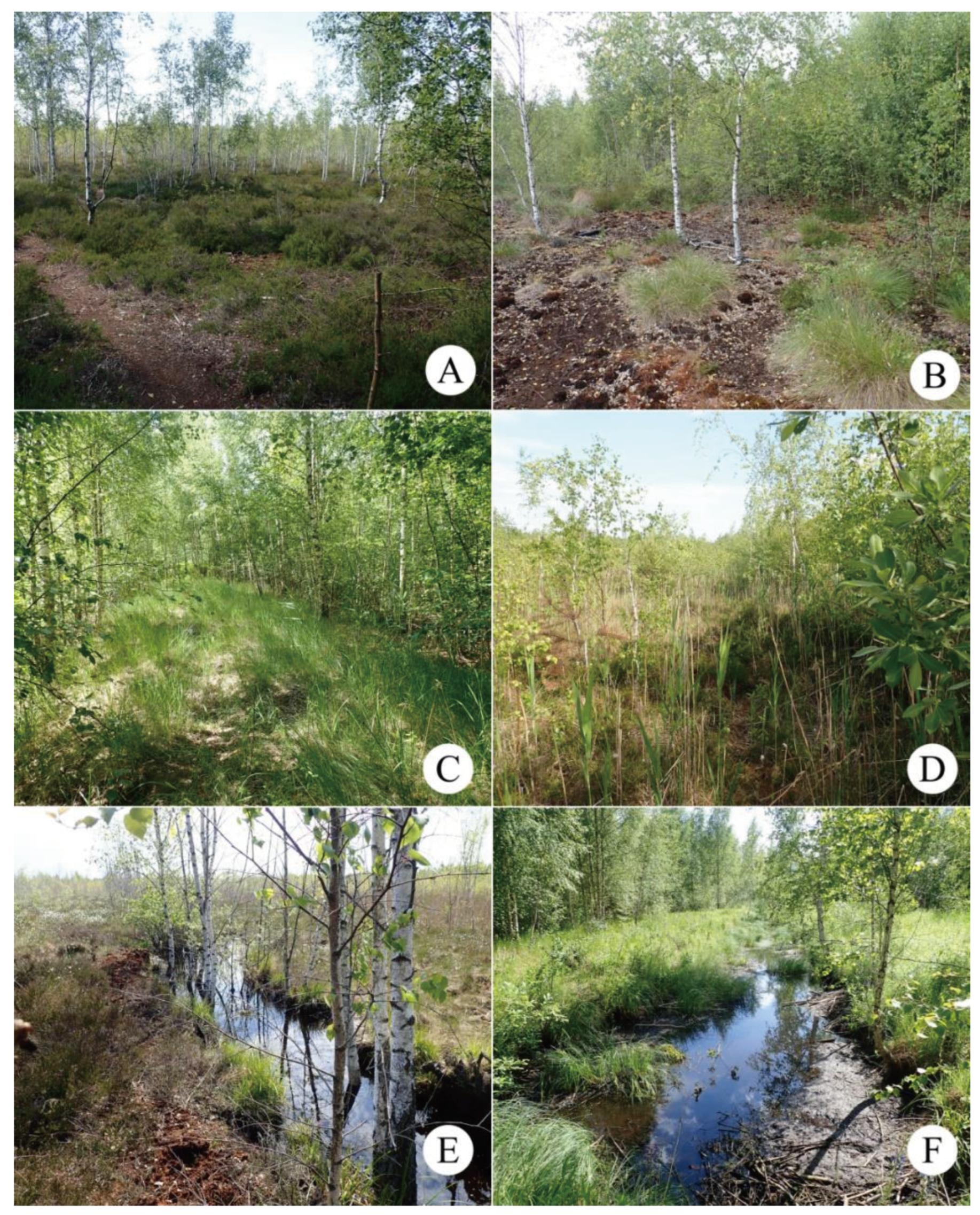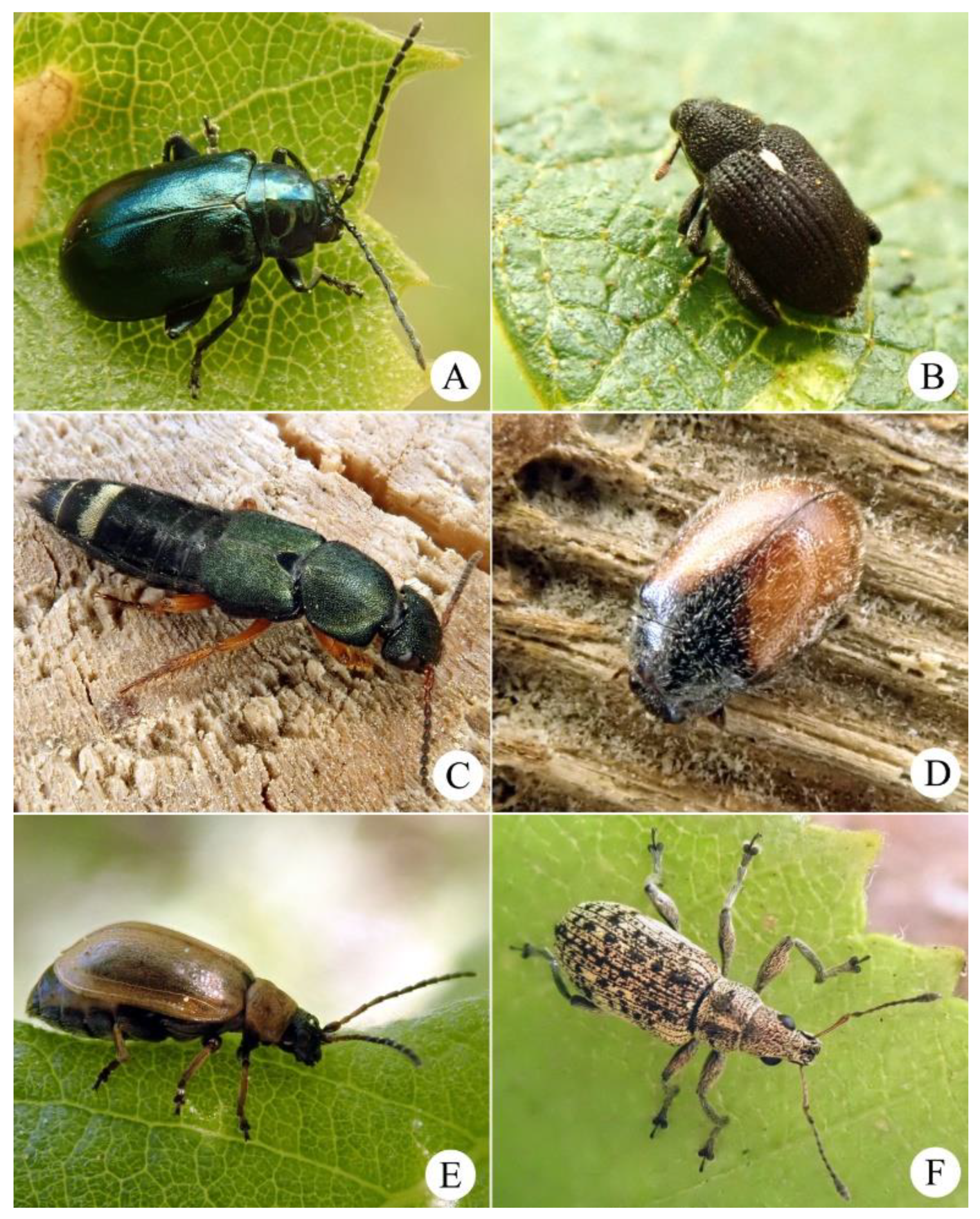Appendix A
Preliminary checklist of beetles (Coleoptera) of the Vittgirrensky peatland.
1. Gyrinidae Latreille, 1810 (1 species)
1.1. Gyrinus substriatus Stephens, 1828 [O]: net; 13.05.2023; C, E; tyrphoneutral.
2. Haliplidae Aubé, 1836 (5 species)
2.1. Haliplus fulvus (Fabricius, 1801) [O]: net; 13.05, 13.06, 13.08.2023; S; tyrphoneutral.
2.2. Haliplus immaculatus Gerhardt, 1877 [O]: net; 07.04, 13.05, 13.06.2023; S; tyrphoneutral.
2.3. Haliplus lineatocollis (Marsham, 1802) [R]: net; 13.05.2023; C; tyrphoneutral.
2.4. Haliplus ruficollis (DeGeer, 1774) [A]: net; 13.05, 13.06, 13.07, 13.08, 17.09, 13.10.2023; C, E, S; tyrphoneutral.
2.5. Peltodytes caesus (Duftschmid, 1805) [O]: net; 13.05, 13.06, 13.07.2023; S; tyrphoneutral.
3. Noteridae Thomson, 1860 (1 species)
3.1. Noterus clavicornis (DeGeer, 1774) [F]: net; 07.04, 13.05, 13.06.2023; S; tyrphoneutral.
4. Dytiscidae Leach, 1815 (28 species)
4.1. Acilius canaliculatus (Nicolai, 1822) [F]: net; 07.04, 13.05, 13.06, 13.07, 13.08, 17.09.2023; C, S, W; tyrphoneutral.
4.2. Acilius sulcatus (Linnaeus, 1758) [O]: net; 13.05, 13.06, 13.08, 17.09, 13.10.2023; E, S; tyrphoneutral.
4.3. Agabus bipustulatus (Linnaeus, 1767) [R]: net; 13.05, 13.06.2023; N, S; tyrphoneutral.
4.4. Clemnius decoratus (Gyllenhal, 1810) [O]: net; 13.05.2023; S, W; tyrphoneutral.
4.5. Dytiscus dimidiatus Bergsträsser, 1778 [R]: net; 13.05, 13.06, 13.08.2023; S, W; tyrphoneutral.
4.6. Graphoderus cinereus (Linnaeus, 1758) [O]: net; 13.05.2023; SW; tyrphoneutral.
4.7. Graptodytes granularis (Linnaeus, 1767) [O]: net; 13.05, 13.06, 13.10.2023; S; tyrphoneutral.
4.8. Graptodytes pictus (Fabricius, 1787) [F]: net; 13.07, 17.09.2023; C, S; tyrphoneutral.
4.9. Hydaticus seminiger (DeGeer, 1774) [O]: net; 13.05.2023; SW; tyrphoneutral.
4.10. Hydaticus transversalis (Pontoppidan, 1763) [R]: net; 13.06, 13.08.2023; S; tyrphoneutral.
4.11. Hydroporus angustatus Sturm, 1835 [F]: net; 07.04, 13.05, 13.06, 17.09, 13.10.2023; C, S, W; tyrphoneutral.
4.12. Hydroporus dorsalis (Fabricius, 1787) [R]: net; 07.04, 13.07, 17.09, 13.10.2023; S, SE; tyrphoneutral.
4.13. Hydroporus erythrocephalus (Linnaeus, 1758) [O]: net; 13.05, 13.06.2023; S, SW; tyrphoneutral.
4.14. Hydroporus glabriusculus Aubé, 1838 [O]: net; 13.07.2023; S; tyrphoneutral.
4.15. Hydroporus neglectus Schaum, 1845 [F]: net; 07.04, 13.05, 13.10.2023; C, N, S, W; tyrphoneutral.
4.16. Hydroporus obscurus Sturm, 1835 [R]: net; 17.09.2023; S, SW; tyrphoneutral.
4.17. Hydroporus palustris (Linnaeus, 1761) [F]: net; 07.04, 13.05, 13.07, 13.08, 17.09.2023; S, W; tyrphoneutral.
4.18. Hydroporus planus (Fabricius, 1782) [R]: net; 13.06, 13.07, 13.08.2023; S, SE; tyrphoneutral.
4.19. Hygrotus impressopunctatus (Schaller, 1783) [F]: net; 07.04, 13.05.2023; S, SW; tyrphoneutral.
4.20. Hygrotus inaequalis (Fabricius, 1777) [F]: net; 07.04, 13.05, 13.07, 13.08, 17.09.2023; C, S, SW, W; tyrphoneutral.
4.21. Hyphydrus ovatus (Linnaeus, 1761) [A]: net; 13.05, 13.06, 13.07, 13.08, 17.09, 13.10.2023; C, S, W; tyrphoneutral.
4.22. Ilybius ater (DeGeer, 1774) [R]: net; 13.05, 13.07, 13.08.2023; S; tyrphoneutral.
4.23. Ilybius guttiger (Gyllenhal, 1808) [R]: net; 13.05.2023; N; tyrphoneutral.
4.24. Laccophilus minutus (Linnaeus, 1758) [O]: net; 07.04, 13.07, 13.08, 17.09, 13.10.2023; S; tyrphoneutral.
4.25. Porhydrus lineatus (Fabricius, 1775) [A]: net; 13.07, 13.08, 17.09.2023; S; tyrphoneutral.
4.26. Rhantus exsoletus (Forster, 1771) [R]: net; 07.04.2023; S; tyrphoneutral.
4.27. Rhantus suturalis (MacLeay, 1825) [R]: net; 13.05.2023; S; tyrphoneutral.
4.28. Scarodytes halensis (Fabricius, 1787) [R]: net; 13.08, 17.09.2023; S; tyrphoneutral.
5. Carabidae Latreille, 1802 (30 species)
5.1. Acupalpus brunnipes (Sturm, 1825) [A]: pitfall; 07.04-13.05, 13.05-13.06, 13.06-13.07, 13.10-17.11.2023; C, N; tyrphophilous.
5.2. Acupalpus meridianus (Linnaeus, 1761) [R]: pitfall; 13.05-13.06.2023; N; tyrphoneutral.
5.3. Amara famelica Zimmermann, 1832 [F]: pitfall; 07.04-13.05, 13.05-13.06, 13.06-13.07, 13.07-13.08, 13.08-17.09, 13.10-17.11.2023; N, SW; tyrphoneutral.
5.4. Badister bullatus (Schrank, 1798) [R]: pitfall; 13.05-13.06, 13.07-13.08.2023; SW; tyrphoxenous.
5.5. Bembidion lampros (Herbst, 1784) [F]: pitfall; 07.04-13.05.2023; N; tyrphoneutral.
5.6. Bembidion quadrimaculatum (Linnaeus, 1761) [O]: pitfall; 07.04-13.05, 13.08-17.09, 17.09-13.10.2023; C, N; tyrphoneutral.
5.7. Bradycellus rufcollis (Stephens, 1828) [R]: pitfall; 17.09-13.10.2023; C, N; tyrphophilous.
5.8. Carabus nemoralis Muller, 1764 [R]: pitfall; 13.07-13.08, 17.09-13.10.2023; SW; tyrphoxenous.
5.9. Cicindela campestris Linnaeus, 1758 [O]: pitfall, visual; 07.04-13.05, 13.05.2023; E, N, SW, W; tyrphoneutral.
5.10. Cymindis vaporariorum (Linnaeus, 1758) [O]: pitfall; 07.04-13.05, 13.07-13.08.2023; C; tyrphoneutral.
5.11. Demetrias monostigma Samouelle, 1819 [O]: net; 13.06.2023; SW, on Phragmítes; tyrphoneutral.
5.12. Dyschirius globosus (Herbst, 1784) [R]: pitfall; 13.06-13.07, 17.09-13.10.2023; C, N; tyrphoneutral.
5.13. Harpalus tardus (Panzer, 1796) [R]: pitfall; 13.06-13.07.2023; C; tyrphoxenous.
5.14. Harpalus fuliginosus (Duftschmid, 1812) [R]: pitfall; 13.07-13.08.2023; SW; tyrphoxenous.
5.15. Leistus ferrugineus (Linnaeus, 1758) [F]: pitfall; 13.06-13.07, 17.09-13.10.2023; C; tyrphoneutral.
5.16. Leistus rufomarginatus (Duftschmid, 1812) [F]: pitfall; 13.05-13.06, 17.09-13.10, 17.09-13.10.2023, C, SW; tyrphoneutral.
5.17. Leistus terminatus (Hellwig, 1793) [A]: pitfall; 13.05-13.06, 13.06-13.07, 13.07-13.08, 13.08-17.09, 17.09-13.10.2023; N, SW; tyrphoneutral.
5.18. Loricera pilicornis (Fabricius, 1775) [O]: pitfall; 13.05-13.06.2023; SW; tyrphoneutral.
5.19. Microlestes maurus (Sturm, 1827) [R]: pitfall; 07.04-13.05.2023; C; tyrphoneutral.
5.20. Microlestes minutulus (Goeze, 1777) [R]: pitfall; 17.09-13.10.2023; N; tyrphoneutral.
5.21. Nebria brevicollis (Fabricius, 1792) [O]: pitfall; 17.09-13.10.2023; N; tyrphoxenous.
5.22. Notiophilus palustris (Duftschmid, 1812) [O]: pitfall; 07.04-13.05, 13.06-13.07, 13.08-17.09.2023; C, N, SW; tyrphoneutral.
5.23. Olisthopus rotundatus (Paykull, 1790) [R]: pitfall; 13.07-13.08.2023; C; tyrphoneutral.
5.24. Ophonus rufibarbis (Fabricius, 1792) [R]: pitfall; 13.07-13.08.2023; N; tyrphoxenous.
5.25. Philorhizus sigma (Rossi, 1790) [R]: pitfall; 13.05-13.06.2023; N; tyrphoneutral.
5.26. Poecilus cupreus (Linnaeus, 1758) [F]: pitfall; 07.04-13.05, 13.05-13.06, 13.08-17.09.2023; C, N, SW; tyrphoneutral.
5.27. Pseudoophonus rufpes (DeGeer, 1774) [R]: pitfall; 13.05-13.06.2023; C; tyrphoxenous.
5.28. Pterostichus anthracinus (Illiger, 1798) [O]: pitfall; 07.04-13.05, 13.05-13.06, 17.09-13.10, 13.10-17.11.2023; C, N; tyrphoneutral.
5.29. Pterostichus crenatus (Duftschmid, 1812) [R]: pitfall; 13.08-17.09.2023; C; tyrphoneutral.
5.30. Pterostichus niger (Schaller, 1783) [A]: pitfall; 13.05-13.06, 13.07-13.08, 13.08-17.09, 17.09-13.10.2023; C, N, SW; tyrphoneutral.
6. Scirtidae Fleming, 1821 (5 species)
6.1. Contacyphon ochraceus (Stephens, 1830) [O]: net; 13.06, 13.07.2023; C; tyrphoneutral.
6.2. Contacyphon padi (Linnaeus, 1758) [F]: net; 13.06, 13.08, 13.10.2023; C, S, SW; tyrphoneutral.
6.3. Contacyphon variabilis (Thunberg, 1785) [F]: net, pitfall; 13.06, 13.07, 13.06-13.07.2023; C, S, SW; tyrphophilous.
6.4. Microcara testacea (Linnaeus, 1767) [O]: net, pitfall; 13.06, 13.06-13.07.2023; S, SW; tyrphoneutral.
6.5. Scirtes hemisphaericus (Linnaeus, 1758) [F]: net; 13.06, 13.07.2023; S, SW; tyrphoneutral.
7. Helophoridae Leach, 1815 (3 species)
7.1. Helophorus aquaticus (Linnaeus, 1758) [F]: net; 13.06.2023; S; tyrphoneutral.
7.2. Helophorus granularis (Linnaeus, 1761) [O]: net; 07.04, 13.05, 13.10.2023; N, E, S; tyrphoneutral.
7.3. Helophorus flavipes Fabricius, 1792 [F]: net; 13.06, 13.07.2023; S; tyrphoneutral.
8. Hydrochidae Thomson, 1859 (1 species)
8.1. Hydrochus elongatus (Schaller, 1783) [R]: net; 13.08.2023; S; tyrphophilous.
9. Hydrophilidae Latreille, 1802 (9 species)
9.1. Anacaena lutescens (Stephens, 1829) [A]: net; 07.04, 13.05, 13.08, 17.09.2023; C, N, S; tyrphoneutral.
9.2. Cymbiodyta marginella (Fabricius, 1792) [R]: net; 13.10.2023; E; ; tyrphoneutral.
9.3. Enochrus coarctatus (Gredler, 1863) [O]: net; 13.05.2023; C, N, S, W; tyrphoneutral.
9.4. Enochrus ochropterus (Marsham, 1802) [O]: net; 13.06.2023; S; tyrphophilous.
9.5. Enochrus testaceus (Fabricius, 1801) [R]: net; 13.05.2023; S; tyrphoneutral.
9.6. Helochares obscurus (Müller, 1776) [O]: net; 13.05, 13.06.2023; S, W; tyrphoneutral.
9.7. Hydrobius fuscipes (Linnaeus, 1758) [R]: net; 13.05.2023; E; tyrphoneutral.
9.8. Hydrochara caraboides (Linnaeus, 1758) [R]: net; 13.05.2023; E; tyrphoxenous.
9.9. Laccobius minutus (Linnaeus, 1758) [R]: net; 17.09, 13.10.2023; N, S; tyrphoneutral.
10. Hydraenidae Mulsant, 1844 (2 species)
10.1. Limnebius crinifer Rey, 1885 [R]: net; 13.05.2023; S; tyrphoneutral.
10.2. Ochthebius minimus (Fabricius, 1792) [R]: net; 13.05.2023; S; tyrphoneutral.
11. Leiodidae Fleming, 1821 (4 species)
11.1. Agathidium plagiatum (Gyllenhal, 1810) [R]: pitfall; 13.06-13.07.2023; N; tyrphoneutral.
11.2. Apocatops nigrita (Erichson, 1837) [A]: pitfall; 07.04-13.05, 13.05-13.06, 13.06-13.07, 13.07-13.08.2023; N, SW; tyrphoneutral.
11.3. Catops fuscus (Panzer 1794) [R]: pitfall; 13.10-17.11.2023; N; tyrphoneutral.
11.4. Sciodrepoides watsoni (Spence, 1813) [A]: pitfall; 13.06-13.07, 13.07-13.08, 17.09-13.10.2023; N, SW; tyrphoneutral.
12. Silphidae Latreille, 1807 (5 species)
12.1. Nicrophorus humator (Gleditsch, 1767) [R]: pitfall; 13.06-13.07.2023; C; tyrphoxenous.
12.2. Nicrophorus vespillo (Linnaeus, 1758) [O]: pitfall; 13.06-13.07, 13.08-17.09.2023; C, N; tyrphoneutral.
12.3. Nicrophorus vespilloides Herbst, 1783 [A]: pitfall; 13.06-13.07, 13.07-13.08, 13.08-17.09.2023; C, N, SW; tyrphoneutral.
12.4. Oiceoptoma thoracica (Linnaeus, 1758) [O]: pitfall; 13.07-13.08, 13.08-17.09.2023; N, SW; tyrphoneutral.
12.5. Phosphuga atrata (Linnaeus, 1758) [R]: pitfall; 07.04-13.05.2023; N; tyrphoxenous.
13. Staphylinidae Latreille, 1802 (45 species)
13.1. Acidota crenata (Fabricius, 1793) [F]: pitfall; 07.04-13.05, 17.09-13.10, 13.10-17.11.2023; C, N; tyrphoneutral.
13.2. Aleochara curtula (Goeze, 1777) [R]: visual; 13.05.2023; E; tyrphoneutral.
13.3. Anthobium unicolor (Marsham, 1802) [A]: pitfall, visual; 07.04-13.05, 13.05-13.06, 13.06-13.07, 13.10, 17.09-13.10, 13.10-17.11, 17.11.2023; C, N, S, SW; tyrphoneutral.
13.4. Bolitochara pulchra (Gravenhorst, 1806) [O]: pitfall; 17.09-13.10.2023; C; tyrphoneutral.
13.5. Brachygluta fossulata (Reichenbach, 1816) [R]: pitfall; 13.05-13.06.2023; SW; tyrphoneutral.
13.6. Brachygluta haematica (Reichenbach, 1816) [O]: pitfall; 13.05-13.06, 13.06-13.07, 13.08-17.09.2023; N, SW; tyrphophilous.
13.7. Carphacis striatus (Olivier, 1795) [R]: visual; 13.07.2023; SW, on rotten Boletaceae; tyrphoneutral.
13.8. Drusilla canaliculata (Fabricius, 1787) [F]: pitfall; 13.05-13.06, 13.06-13.07, 13.08-17.09, 17.09-13.10.2023; C, N, SW; tyrphoneutral.
13.9. Euconnus claviger (Müller & Kunze, 1822) [O]: pitfall; 07.04-13.05.2023; C; tyrphoneutral.
13.10. Euconnus wetterhallii (Gyllenhal, 1813) [O]: pitfall; 07.04-13.05, 13.06-13.07.2023; C, SW; tyrphoneutral.
13.11. Eusphalerum minutum (Fabricius, 1792) [R]: visual; 13.06.2023; W; tyrphoneutral.
13.12. Gyrophaena joyi Wendeler, 1924 [F]: visual; 13.08.2023; SW, on Basidiomycota; tyrphoneutral.
13.13. Habrocerus capillaricornis (Gravenhorst, 1806) [R]: visual; 17.11.2023; S, in rotten wood; tyrphoneutral.
13.14. Hygronoma dimidiata (Gravenhorst, 1806) [R]: visual; 13.08.2023; SW, ditch shore; tyrphoneutral.
13.15. Ischnosoma longicorne (Mäklin, 1847) [F]: pitfall; 07.04-13.05, 13.05-13.06, 13.08.-17.09, 13.10-17.11.2023; C, N; tyrphophilous.
13.16. Lesteva longoelytrata (Goeze, 1777) [O]: visual, pitfall; 13.05, 13.05-13.06.2023; E, SW, W, near open water; tyrphoneutral.
13.17. Lordithon thoracicus (Fabricius, 1777) [R]: pitfall; 13.08-17.09.2023; C; tyrphoxenous.
13.18. Mycetoporus lepidus (Gravenhorst, 1806) [O]: pitfall; 07.04-13.05, 13.07-13.08, 13.10-17.11.2023; C, N; tyrphoneutral.
13.19. Ocypus brunnipes (Fabricius, 1781) [R]: pitfall; 17.09-13.10.2023; C; tyrphoxenous.
13.20. Olophrum piceum (Gyllenhal, 1810) [F]: pitfall; 07.04-13.05, 13.10-17.11.2023; C, N; tyrphoneutral.
13.21. Omalium rivulare (Paykull, 1789) [R]: visual; 17.11.2023; S; tyrphoneutral.
13.22. Oxypoda opaca (Gravenhorst, 1802) [F]: pitfall, visual; 13.07, 13.06-13.07, 13.08, 13.08-17.09, 13.10-17.11.2023; C, N, SW; tyrphoneutral.
13.23. Oxyporus rufus (Linnaeus, 1758) [O]: visual; 13.07.2023; SW, on rotten Boletaceae; tyrphoneutral.
13.24. Parabolitobius inclinans (Gravenhorst, 1806) [F]: pitfall; 07.04-13.05.2023; C; tyrphoneutral.
13.25. Philonthus cognatus Stephens, 1832 [F]: pitfall, visual; 07.04-13.05, 13.05-13.06, 13.08, 13.07-13.08.2023; C, E, N; tyrphoneutral.
13.26. Philonthus decorus (Gravenhorst, 1802) [R]: pitfall; 17.09-13.10.2023; SW; tyrphoneutral.
13.27. Philonthus splendens (Fabricius, 1793) [R]: pitfall; 13.07-13.08.2023; SW; tyrphoneutral.
13.28. Platydracus fulvipes (Scopoli, 1763) [O]: pitfall; 13.05-13.06, 13.06-13.07, 13.07-13.08.2023; N, SW; tyrphophilous.
13.29. Platydracus latebricola (Gravenhorst, 1806) [F]: pitfall; 13.05-13.06, 13.06-13.07, 13.07-13.08.2023; N, SW; tyrphophilous.
13.30. Proteinus brachypterus (Fabricius, 1792) [O]: pitfall; 07.04, 13.06-13.07, 17.11.2023; S, SW, W, on dung and rotten mushrooms; tyrphoneutral.
13.31. Pselaphus heisei Herbst, 1792 [R]: pitfall; 07.04-13.05.2023; C; tyrphophilous.
13.32. Sepedophilus testaceus (Fabricius, 1793) [O]: pitfall; 13.06-13.07, 13.07-13.08, 17.09-13.10.2023; C, N; tyrphoneutral.
13.33. Stenichnus scutellaris (Müller & Kunze, 1822) [R]: pitfall; 13.05-13.06, 13.06-13.07.2023; C, SW; tyrphoneutral.
13.34. Stenus bimaculatus Gyllenhal, 1810 [R]: visual; 13.05.2023; E, near open water; tyrphoneutral.
13.35. Stenus clavicornis (Scopoli, 1763) [R]: pitfall; 13.08-17.09.2023; N; tyrphoneutral.
13.36. Stenus solutus Erichson, 1840 [R]: pitfall, visual; 07.04-13.05, 13.05, 13.05-13.06, 17.09-13.10, 13.10, 13.10-17.11.2023; C, N, SW; tyrphoneutral.
13.37. Tachinus corticinus Gravenhorst, 1802 [R]: net, visual; 13.06, 13.08.2023; C, E; tyrphoneutral.
13.38. Tachyporus dispar (Paykull, 1789) [A]: pitfall; 13.10-17.11.2023; C, N; tyrphoneutral.
13.39. Tachyporus hypnorum (Fabricius, 1775) [F]: pitfall, visual; 07.04-13.05, 13.10, 13.10-17.11.2023; C, N; tyrphoneutral.
13.40. Tachyporus nitidulus (Fabricius, 1781) [R]: pitfall; 17.09-13.10.2023; C, N; tyrphoneutral.
13.41. Xantholinus longiventris Heer, 1839 [A]: pitfall; 07.04-13.05, 13.05-13.06, 13.06-13.07, 13.07-13.08, 13.08-17.09, 17.09-13.10, 13.10-17.11.2023; C, N, SW; tyrphoneutral.
13.42. Zyras collaris (Paykull, 1800) [O]: pitfall; 13.08-17.09.2023; C, N; tyrphoneutral.
13.43. Zyras lugens (Gravenhorst, 1802) [F]: pitfall; 07.04-13.05, 13.07-13.08.2023; C; tyrphoneutral.
14. Lucanidae Latreille, 1804 (1 species)
14.1. Dorcus parallelepipedus (Linnaeus, 1758) [R]: visual; 13.06.2023; N, on central road; tyrphoxenous.
15. Scarabaeidae Latreille, 1802 (6 species)
15.1. Agrilinus rufus (Moll, 1782) [O]: visual; 13.08.2023; E, in dung; tyrphoxenous.
15.2. Aphodius fimetarius (Linnaeus, 1758) [R]: visual; 13.08.2023; E, in dung; tyrphoxenous.
15.3. Melolontha melolontha (Linnaeus, 1758) [O]: visual; 13.05, 13.06.2023; S, on Betula; tyrphoneutral.
15.4. Oxythyrea funesta (Poda, 1761) [R]: visual; 13.07.2023; N; tyrphoxenous.
15.5. Serica brunnea (Linnaeus, 1758) [F]: pitfall; 13.06-13.07, 13.07-13.08.2023; N, SW; tyrphoneutral.
15.6. Trichius fasciatus (Linnaeus, 1758) [R]: visual; 13.07.2023; N; tyrphoxenous.
16. Buprestidae Leach, 1815 (1 species)
16.1. Trachys minutus (Linnaeus, 1758) [O]: visual, net; 13.06, 13.07, 13.08.2023; C, S, on Salix; tyrphoneutral.
17. Byrrhidae Latreille, 1804 (2 species)
17.1. Curimopsis nigrita (Palm, 1934) [A]: pitfall; 07.04-13.05, 13.05-13.06, 13.06-13.07.2023; C, N; tyrphophilous.
17.2. Cytilus sericeus (Forster, 1771) [R]: pitfall; 13.06-13.07.2023; SW; tyrphoxenous.
18. Throscidae Laporte, 1840 (2 species)
18.1. Aulonothroscus brevicollis (Bonvouloir, 1859) [R]: pitfall; 17.09-13.10.2023; C; tyrphoneutral.
18.2. Trixagus dermestoides (Linnaeus, 1767) [R]: pitfall; 13.05-13.06, 13.06-13.07, 13.07-13.08.2023; C, SW; tyrphoneutral.
19. Elateridae Leach, 1815 (11 species)
19.1. Adrastus pallens (Fabricius, 1792) [F]: net; 13.07.2023; S; tyrphoneutral.
19.2. Agriotes ustulatus (Schaller, 1783) [R]: pitfall; 13.05-13.06.2023; N, SW; tyrphoneutral.
19.3. Agrypnus murinus (Linnaeus, 1758) [R]: net; 13.05, 13.06.2023; C, S; tyrphoneutral.
19.4. Ampedus balteatus (Linnaeus, 1758) [F]: net, visual, pitfall; 13.05, 13.06, 13.06-13.07.2023; C, E, N, S, SW; tyrphoneutral.
19.5. Ampedus pomorum (Herbst. 1784) [O]: net, visual; 13.05, 13.05-13, 13.06-13.07.2023; C, N; tyrphoneutral.
19.6. Ampedus sanguineus (Linnaeus, 1758) [R]: visual; 13.06.2023; S; tyrphoneutral.
19.7. Cidnopus aeruginosus (Olivier, 1790) [F]: net; 13.05.2023; C, N, S, W; tyrphoneutral.
19.8. Dalopius marginatus (Linnaeus, 1758) [R]: net; 13.05-13.06, 13.06-13.07.2023; N, SW; tyrphoneutral.
19.9. Hemicrepidius niger (Linnaeus, 1758) [O]: net; 13.06.2023; S; tyrphoxenous.
19.10. Melanotus villosus (Geoffroy, 1785) [R]: net; 13.05.2023; E; tyrphoneutral.
19.11. Sericus brunneus (Linnaeus, 1758) [O]: net; 13.05.2023; C, N; tyrphoneutral.
20. Cantharidae Imhoff, 1856 (1815) (13 species)
20.1. Cantharis flavilabris Fallén, 1807 [F]: net; 13.06, 13.07.2023; S, SW; tyrphoneutral.
20.2. Cantharis livida Linnaeus, 1758 [O]: net; 13.06.2023; C, along central road; tyrphoxenous.
20.3. Cantharis nigricans (Müller, 1776) [O]: net; 13.06.2023; C; tyrphoneutral.
20.4. Cantharis pallida Goeze, 1777 [O]: net; 13.06.2023; W; tyrphoneutral.
20.5. Cantharis pellucida Fabricius, 1792 [O]: net; 13.06.2023; C; tyrphoneutral.
20.6. Cantharis rufa Linnaeus, 1758 [O]: net; 13.06.2023; SW; tyrphoxenous.
20.7. Malthodes marginatus (Latreille, 1806) [R]: net; 13.06, 13.07.2023; S, SW; tyrphoneutral.
20.8. Malthodes minimus (Linnaeus, 1758) [R]: net; 13.06.2023; SW; tyrphoneutral.
20.9. Malthodes pumilus (Brébisson, 1835) [O]: net; 13.06.2023; SW, on Calluna; tyrphophilous.
20.10. Rhagonycha fulva (Scopoli, 1763) [A]: net; 13.07.2023; C, N, S; tyrphoxenous.
20.11. Rhagonycha lignosa (Müller, 1764) [O]: net; 13.06.2023; SW; tyrphoneutral.
20.12. Rhagonycha nigriventris Motschulsky, 1860 [R]: net; 13.05.2023; C; tyrphoneutral.
20.13. Rhagonycha testacea (Linnaeus, 1758) [O]: net; 13.06.2023; SW; tyrphoxenous.
21. Dermestidae Latreille, 1804 (1 species)
21.1. Dermestes murinus Linnaeus, 1758 [F]: pitfall; 13.06-13.07, 13.08-17.09.2023; C, N; tyrphoneutral.
22. Latridiidae Erichson, 1842 (1 species)
22.1. Melanophthalma transversalis (Gyllenhal, 1827) [O]: net; 13.06, 13.08.2023; C, along central road; tyrphoxenous.
23. Endomychidae Leach, 1815 (1 species)
23.1. Endomychus coccineus (Linnaeus, 1758) [O]: visual, net; 07.04, 13.06.2023; S, E, larvae on a birch stump with Stereum hirsutum; tyrphoneutral.
24. Coccinellidae Latreille, 1807 (10 species)
24.1. Chilocorus renipustulatus (Scriba, 1791) [O]: net; 13.07.2023; S, SW; tyrphoneutral.
24.2. Coccinella hieroglyphica Linnaeus, 1758 [O]: pitfall; 13.06-13.07.2023; N; tyrphoneutral.
24.3. Coccinella septempunctata Linnaeus, 1758 [F]: net, pitfall; 13.06, 13.07, 17.09-13.10.2023; C, N; tyrphoneutral.
24.4. Halyzia sedecimguttata (Linnaeus, 1758) [R]: net; 13.07.2023; SW; tyrphoneutral.
24.5. Harmonia axyridis (Pallas, 1773) [F]: net, visual; 13.06 [larva], 13.07, 13.08.2023; C, along road; tyrphoxenous.
24.6. Propylea quatuordecimpunctata (Linnaeus, 1758) [F]: net; 13.05, 13.06, 13.07, 13.08.2023; C, E, N, SW, W; tyrphoneutral.
24.7. Psyllobora vigintiduopunctata (Linnaeus, 1758) [F]: net; 13.05, 13.07, 17.09.2023; C, S, SW; tyrphoneutral.
24.8. Scymnus suturalis Thunberg, 1795 [O]: net, pitfall; 13.05-13.06, 13.06, 13.06-13.07, 13.07, 13.08, 13.08-17.09, 17.09-13.10.2023; C, N, SW; tyrphophilous.
24.9. Stethorus punctillum (Weise, 1891) [R]: net; 13.08.2023; C; tyrphoxenous.
24.10. Tytthaspis sedecimpunctata (Linnaeus, 1761) [O]: net; 13.07, 13.08.2023; C; tyrphoneutral.
25. Mordellidae Latreille, 1802 (3 species)
25.1. Mordella aculeata Linnaeus, 1758 [F]: net, pitfall; 13.06-13.07, 13.08, 13.08-17.09.2023; C, N; tyrphoneutral.
25.2. Mordellistena koelleri Ermisch, 1956 [R]: net; 13.06.2023; C; tyrphoneutral.
25.3. Variimorda villosa (Schrank, 1781) [F]: net; 13.07.2023; C, along central road on Apiaceae; tyrphoneutral.
26. Tenebrionidae Latreille, 1802 (2 species)
26.1. Isomira murina (Linnaeus, 1758) [R]: net; 13.06.2023; C; tyrphoneutral.
26.2. Lagria hirta (Linnaeus, 1758) [A]: net; 13.07.2023; C, N, S; tyrphoneutral.
27. Oedemeridae Latreille, 1810 (4 species)
27.1. Anogcodes melanurus (Fabricius, 1787) [R]: net; 13.07.2023; N; tyrphoxenous.
27.2. Oedemera croceicollis (Gyllenhal, 1827) [O]: net; 13.06.2023; SW; tyrphoneutral.
27.3. Oedemera lurida (Marsham, 1802) [F]: net; 13.07.2023; C, N, S; tyrphoneutral.
27.4. Oedemera virescens (Linnaeus, 1767) [R]: net; 13.05.2023; S; tyrphoxenous.
28. Pyrochroidae Latreille, 1806 (1 species)
28.1. Schizotus pectinicornis (Linnaeus, 1758) [O]: visual; 13.05 (adult), 17.11.2023 (larva); S, larvae under bark of birch stump; tyrphoneutral.
29. Scraptiidae Mulsant, 1856/Gistel, 1856 (1 species)
29.1. Anaspis frontalis (Linnaeus, 1758) [O]: net; 13.06.2023; C, S; tyrphoneutral.
30. Byturidae Jacquelin du Val, 1858 (1 species)
30.1. Byturus ochraceus (Scriba, 1790) [O]: net; 13.05.2023; E; tyrphoxenous.
31. Melyridae Leach, 1815 (3 species)
31.1. Cordylepherus viridis (Fabricius, 1787) [O]: net; 13.06, 13.07.2023; C, S; tyrphoneutral.
31.2. Dasytes niger (Linnaeus, 1761) [R]: pitfall; 13.07-13.08.2023; N; tyrphoneutral.
31.3. Dasytes plumbeus (Müller, 1776) [F]: pitfall, net; 13.06-13.07, 13.07; C, N, SW; tyrphoneutral.
32. Cryptophagidae Kirby, 1837 (2 species)
32.1. Cryptophagus lycoperdi (Scopoli, 1763) [A]: visual, pitfall; 13.08, 13.08-17.09.2023; N, SW, W, associated with Scleroderma citrinum; tyrphoneutral.
32.2. Telmatophilus typhae (Fallén, 1802) [F]: net; 13.07.2023; C, S, associated with Typha latifolia; tyrphoneutral.
33. Phalacridae Leach, 1815 (1 species)
33.1. Phalacrus championi Guillebeau, 1892 [R]: net; 13.06, 13.07.2023; C, W; tyrphoneutral.
34. Kateretidae Kirby, 1837 (1 species)
34.1. Brachypterus urticae (Fabricius, 1792) [A]: net; 13.06, 13.07.2023; C, on Urtica dioica; tyrphoxenous.
35. Nitidulidae Latreille, 1802 (4 species)
35.1. Brassicogethes aeneus (Fabricius, 1775) [O]: net; 13.06.2023; S, along central road; tyrphoneutral.
35.2. Brassicogethes viridescens (Fabricius, 1787) [O]: net; 13.07.2023; C, along central road; tyrphoneutral.
35.3. Meligethes flavimanus Stephens, 1830 [R]: pitfall; 13.06-13.07.2023; N; tyrphoxenous.
35.4. Pocadius ferrugineus (Fabricius, 1775) [O]: pitfall, visual; 13.06-13.07, 13.07.2023; SW; tyrphoneutral.
36. Cerambycidae Latreille, 1802 (8 species)
36.1. Agapanthia villosoviridescens (DeGeer, 1775) [O]: net; 13.06, 13.07.2023; S; tyrphoxenous.
36.2. Lamia textor (Linnaeus, 1758) [R]: visual; 13.07.2023; N; tyrphoneutral.
36.3. Leptura quadrifasciata Linnaeus, 1758 [O]: visual, net; 13.07.2023; C, S, along central road on Apiaceae; tyrphoneutral.
36.4. Stenurella melanura (Linnaeus, 1758) [O]: visual; 13.07.2023; N, along central road on Apiaceae; tyrphoneutral.
36.5. Stenurella nigra (Linnaeus, 1758) [O]: visual; 13.06.2023; S, along central road on Apiaceae; tyrphoneutral.
36.6. Stictoleptura maculicornis (De Geer, 1775) [R]: net; 13.07.2023; C, along central road on Apiaceae; tyrphoneutral.
36.7. Stictoleptura rubra (Linnaeus, 1758) [O]: visual; 13.07, 13.08.2023; N, S; tyrphoneutral.
36.8. Strangalia attenuata (Linnaeus, 1758) [R]: net; 13.07.2023; C, along central road on Apiaceae; tyrphoneutral.
37. Megalopodidae Latreille, 1802 (1 species)
37.1. Zeugophora subspinosa (Fabricius, 1781) [R]: net; 13.06.2023; E, on Populus tremulae; tyrphoneutral.
38. Chrysomelidae Latreille, 1802 (24 species)
38.1. Agelastica alni (Linnaeus, 1758) [O]: net, pitafall; 13.05, 13.05-13.06.2023; N; tyrphoneutral.
38.2. Altica aenescens Weise, 1888 [A]: visual, net; 13.05, 13.06, 13.07, 13.08.2023; C, E, N, W, on leaves of Betula pubescens; tyrphoneutral.
38.3. Altica chamaenerii (Lindberg, 1926) [O]: net, pitfall; 13.05, 13.08-17.09.2023; C, N, on leaves of Chamaenerion angustifolium; tyrphoneutral.
38.4. Altica longicollis (Allard, 1860) [A]: pitfall; 07.04-13.05, 13.05-13.06, 13.06-13.07, 13.07-13.08.2023; C, N, in Calluna-communities; tyrphophilous.
38.5. Batophila rubi (Paykull, 1799) [F]: net; 13.05, 13.06, 13.06-13.07, 13.07.2023; C, N, along road on Rubus idaeus; tyrphoxenous.
38.6. Bromius obscurus (Linnaeus, 1758) [F]: visual, net; 13.05.2023; C, N, along central road on Chamaenerion angustifolium; tyrphoneutral.
38.7. Cassida denticollis Suffrian, 1844 [O]: net; 13.07.2023; S, along central road on Achillea millefolium; tyrphoxenous.
38.8. Cassida rubiginosa Müller, 1776 [F]: net; 13.05, 13.08, 17.09.2023; C, N, S, on Cirsium arvense; tyrphoxenous.
38.9. Cassida viridis Linnaeus, 1758 [R]: pitfall; 13.05-13.06.2023; N; tyrphoneutral.
38.10. Chrysomela populi Linnaeus, 1758 [R]: net; 13.05.2023; S, on regrowth of Populus tremulae; tyrphoneutral.
38.11. Crepidodera aurata (Marsham, 1802) [F]: net; 13.05, 13.07.2023; C, S, on leaves of Salix sp.; tyrphoneutral.
38.12. Cryptocephalus decemmaculatus (Linnaeus, 1758) [O]: net; 13.06.2023; C, on leaves of Salix sp.; tyrphoneutral
38.13. Cryptocephalus ocellatus Drapiez, 1819 [O]: net; 13.06, 13.07.2023; C, on leaves of Salix sp.; tyrphoneutral
38.14. Cryptocephalus pusillus Fabricius, 1777 [R]: pitfall, net; 13.06-13.07, 13.07.2023; C, N.; tyrphoneutral
38.15. Galeruca tanaceti (Linnaeus, 1758) [R]: net; 13.08.2023; N, central road; tyrphoxenous.
38.16. Lochmaea caprea (Linnaeus, 1758) [A]: visual, net, pitfall; 13.05, 13.05-13.06, 13.06, 13.06-13.07, 13.08, 13.08-17.09.2023; C, N, S, SW, on Salix and Betula; tyrphoneutral.
38.17. Longitarsus jacobaeae (Waterhouse, 1858) [R]: net; 13.08.2023; C, along central road; tyrphoxenous.
38.18. Neocrepidodera transversa (Marsham, 1802) [A]: net; 13.06, 13.07, 13.08.2023; C, N, S, on Cirsium arvense; tyrphoxenous.
38.19. Oulema obscura (Stephens, 1831) [R]: net; 13.05, 13.07.2023; C, N, central road; tyrphoneutral.
38.20. Oulema melanopus (Linnaeus, 1758) [R]: net; 13.07.2023; N; tyrphoxenous.
38.21. Pachybrachis hieroglyphicus (Laicharting, 1781) [R]: net; 13.06.2023; C, on leaves of Salix sp.; tyrphoneutral.
38.22. Phyllotreta atra (Fabricius, 1775) [R]: net; 13.07, 17.09.2023; C, SW; tyrphoneutral.
38.23. Phyllotreta striolata (Illiger, 1803) [R]: net; 13.07, 13.08.2023; C, SW; tyrphoneutral.
38.24. Psylliodes chalcomerus (Illiger, 1807) [F]: net, visual; 13.05, 13.07.2023; C, N, along road on Carduus; tyrphoxenous.
39. Attelabidae Billberg, 1820 (3 species)
39.1. Byctiscus betulae (Linnaeus, 1758) [R]: net; 13.05.2023; C, on Salix sp. ; tyrphoneutral.
39.2. Byctiscus populi (Linnaeus, 1758) [O]: net; 13.06.2023; E, on regrowth of Populus trmulae; tyrphoneutral.
39.3. Temnocerus coeruleus (Fabricius, 1798) [O]: net; 13.06.2023; C, along road on Salix sp.; tyrphoneutral.
40. Brentidae Billberg, 1820 (6 species)
40.1. Betulapion simile (Kirby, 1811) [R]: net; 13.06.2023; S, on Betula sp.; tyrphoneutral.
40.2. Ceratapion onopordi (Kirby, 1808) [R]: net; 13.05, 13.10.2023; C, along road on Carduus crispus; tyrphoxenous.
40.3. Eutrichapion ervi (Kirby, 1808) [R]: net; 13.06.2023; C, along central road on Lathyrus pratensis; tyrphoxenous.
40.4. Nanophyes marmoratus (Goeze, 1777) [O]: net; 13.07.2023; C, on Lythrum salicaria near open water; tyrphoneutral.
40.5. Oxystoma cerdo (Gerstaecker, 1854) [R]: net; 13.05, 13.07.2023; C, along road on Vicia cracca; tyrphoxenous.
40.6. Protapion fulvipes (Geoffroy, 1785) [O]: net; 13.06.2023; C, along road on Trifolium repens; tyrphoxenous.
41. Curculionidae Latreille, 1802 (30 species)
41.1. Anthonomus rubi (Herbst, 1795) [O]: net; 13.06, 13.08.2023; C, along road on Rubus idaeus; tyrphoxenous.
41.2. Archarius salicivorus (Paykull, 1792) [R]: net; 13.06.2023; C, along central road on Salix sp.; tyrphoneutral.
41.3. Barypeithes pellucidus (Boheman, 1834) [A]: pitfall; 13.06-13.07.2023; SW; tyrphoxenous.
41.4. Brachysomus echinatus (Bonsdorff, 1785) [A]: net; 13.05-13.06, 13.06-13.07.2023; SW; tyrphoneutral.
41.5. Calosirus terminatus (Herbst, 1795) [O]: net; 13.07, 13.10.2023; C, N, along road; tyrphoxenous.
41.6. Ceutorhynchus obstrictus (Marsham, 1802) [O]: net; 13.07.2023; N, along road; tyrphoxenous.
41.7. Cleonis pigra (Scopoli, 1763) [O]: visual, pitfall; 13.05, 13.05-13.06.2023; N; tyrphoxenous.
41.8. Cryptorhynchus lapathi (Linnaeus, 1758) [R]: net; 13.06.2023; C; tyrphoneutral.
41.9. Hypera arator (Linnaeus, 1758) [R]: pitfall; 07.04-13.05.2023; N; tyrphoxenous.
41.10. Hypera nigrirostris (Fabricius, 1775) [R]: pitfall; 13.06-13.07.2023; SW; tyrphoxenous.
41.11. Hypera postica (Gyllenhal, 1813) [R]: net; 13.08.2023; S; tyrphoxenous.
41.12. Larinus turbinatus Gyllenhal, 1835 [R]: net; 13.06.2023; N, along road on Carduus; tyrphoxenous.
41.13. Micrelus ericae (Gyllenhal, 1813) [R]: pitfall; 13.06-13.07.2023; N, in Calluna community; tyrphophilous.
41.14. Nedyus quadrimaculatus (Linnaeus, 1758) [O]: net; 13.05.2023; S, on Urtica dioica; tyrphoxenous.
41.15. Orchestes jota (Fabricius, 1787) [F]: net; 13.05, 13.06, 13.08.2023; C, N, S, W, on Betula; tyrphoneutral.
41.16. Otiorhynchus ovatus (Linnaeus, 1758) [O]: pitfall; 13.07-13.08, 17.09-13.10.2023; C, N; tyrphoxenous.
41.17. Otiorhynchus tristis (Scopoli, 1763) [R]: net; 13.07.2023; N; tyrphoxenous.
41.18. Phyllobius argentatus (Linnaeus, 1758) [R]: net; 13.06.2023; C; tyrphoneutral.
41.19. Phyllobius pomaceus Gyllenhal, 1834 [F]: net; 13.06.2023; C, S, along road on Urtica dioica; tyrphoxenous.
41.20. Phyllobius pyri (Linnaeus, 1758) [R]: net; 13.05.2023; S; tyrphoneutral.
41.21. Polydrusus cervinus (Linnaeus, 1758) [F]: net, pitfall; 13.05, 13.05-13.06, 13.06, 13.06-13.07, 13.07.2023; C, E, N, S, SW, on Betula; tyrphoneutral.
41.22. Polydrusus picus (Fabricius, 1792) [A]: net, visual; 13.06, 13.07.2023; C, S, SW, on Salix sp.; tyrphoneutral.
41.23. Rhamphus pulicarius (Herbst, 1795) [O]: net, visual; 13.05, 13.06.2023; C, SW, on Salix sp.; tyrphoneutral.
41.24. Rhinocyllus conicus (Frölich, 1792) [F]: net; 13.05, 13.06, 13.07.2023; C, N, along road on Carduus; tyrphoxenous.
41.25. Rhinusa linariae (Panzer, 1793) [R]: net; 13.07.2023; C, along road on Linaria vulgaris; tyrphoxenous.
41.26. Rutidosoma graminosum (Gistel, 1857) [R]: net; 13.06.2023; SW; tyrphoneutral.
41.27. Sciaphilus asperatus (Bonsdorff, 1785) [F]: pitfall; 13.06-13.07, 13.07-13.08.2023; SW; tyrphoneutral.
41.28. Sitona hispidulus (Fabricius, 1777) [O]: net; 13.08.2023; S; tyrphoneutral.
41.29. Sitona lineatus (Linnaeus, 1758) [R]: pitfall; 07.04-13.05.2023; N; tyrphoxenous.
41.30. Tanymecus palliatus (Fabricius, 1787) [F]: net; 13.06.2023; C, along central road; tyrphoxenous.








